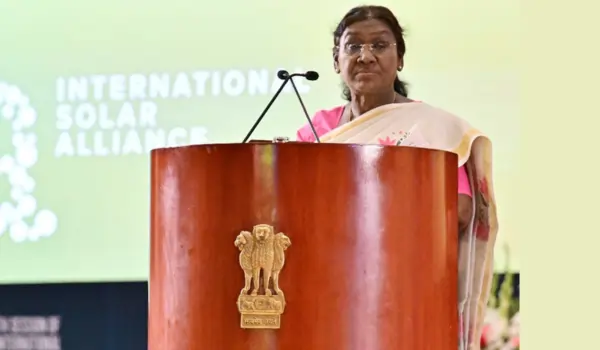New Delhi: The Eighth Session of the International Solar Alliance (ISA) Assembly commenced today at the iconic Bharat Mandapam convention centre in the national capital, drawing participation from 124 Member and Signatory Countries and over 40 Ministers representing diverse geographies. Inaugurated by President Droupadi Murmu, the four-day global gathering aims to review progress, address challenges, and align actions toward one vision – affordable solar energy for all. The event underscores the ISA’s pivotal role as the largest treaty-based intergovernmental organisation from the Global South, headquartered in Gurugram, India – the first international intergovernmental organization headquartered in India.

President Droupadi Murmu Inaugurates ISA Assembly: Solar Energy as a Tool for Inclusion, Dignity, and Collective Prosperity
In her inaugural address at the opening plenary, President Droupadi Murmu emphasized that the ISA represented “humanity’s shared aspiration to harness solar energy as a source of inclusion, dignity, and collective prosperity.” Speaking to delegates from across the globe, she urged the international community to view solar energy not merely as a tool for power generation but as a means of empowerment and inclusive growth.
“Access to affordable and clean energy empowers communities, drives local economies, and opens up opportunities that extend well beyond electricity,” President Murmu stated. She highlighted the urgency of the climate crisis, noting that India was taking “determined steps” to combat global warming. The ISA, she added, offered a vital platform for advancing the adoption of clean, renewable energy worldwide.
Drawing from India’s own development journey, the President stressed that energy equity formed the basis of social equity. She called on ISA member countries to “think beyond infrastructure” and frame a collective action plan that links solar energy with employment, women’s leadership, rural livelihoods, and digital inclusion. “Our progress should be measured not only in megawatts but in the number of lives illuminated, families strengthened, and communities transformed,” she asserted.
President Murmu also cautioned against disturbing regional ecological balance through large-scale solar installations. “Environment conservation is the very reason for turning to green energy,” she reminded the assembly. Advocating for shared innovation and technology transfer, she urged member nations to work with greater dedication “not only for our own countries but for the entire world, and not only for the present generation but for future generations.” She expressed confidence that the Assembly’s deliberations would mark a milestone in advancing solar energy production and help build “an inclusive and equitable world.”
Genesis and Evolution of the International Solar Alliance: From COP21 Vision to Global South Leadership
The International Solar Alliance traces its genesis to a landmark initiative launched in 2015 by India and France at COP21 in Paris. Conceived as a global intergovernmental organization, the ISA has grown into the largest treaty-based intergovernmental organisation from the Global South. Its headquarters in Gurugram, India, marks a historic milestone as the first international intergovernmental organization headquartered in India.
Following a 2020 amendment to its Framework Agreement, all UN member states are now eligible to join the Alliance, expanding its reach and influence. Currently, the ISA boasts 124 Member and Signatory Countries, reflecting broad-based international commitment to solar energy adoption.
The Alliance’s core aim is to bring clean, reliable, and affordable energy to communities, driving sustainable growth and improving quality of life. Its mission focuses on unlocking $1 trillion in solar investments by 2030 while reducing technology and financing costs. The ISA promotes the use of solar energy in the agriculture, health, transport, and power generation sectors, working with governments to improve energy access and security worldwide and promote solar power as a sustainable transition to a carbon-neutral future.
Key collaborative initiatives under the ISA umbrella include the SolarX Startup Challenge, STAR-C Initiative, Global Solar Facility, and the ambitious One Sun, One World, One Grid (OSOWOG) project. These programs exemplify the Alliance’s commitment to innovation, capacity building, and cross-border cooperation in the solar domain.
Key Highlights of the Eighth ISA Assembly Session: Groundbreaking Launches and Strategic Partnerships
The Eighth Session witnessed several landmark announcements that promise to accelerate global solar adoption and sustainability:
- Launch of SUNRISE (Solar Upcycling Network for Recycling, Innovation & Stakeholder Engagement): This global initiative focuses on promoting solar waste recycling, green employment, and circular economy principles. SUNRISE aims to address the growing challenge of end-of-life solar panels while creating new job opportunities in the green sector.
- Small Island Developing States (SIDS) Procurement MoU: 16 SIDS joined hands under an ISA-World Bank platform for coordinated solar procurement and capacity building. This memorandum of understanding will enable bulk purchasing of solar technologies at reduced costs and enhance technical expertise in vulnerable island nations.
- Release of ISA’s Flagship Reports: The Assembly unveiled two comprehensive studies – Ease of Doing Solar 2025 and Solar Trends 2025. These reports provide critical insights into market dynamics, investment opportunities, and policy frameworks shaping the global solar landscape.
- Global Capability Centre Unveiled: A new Global Capability Centre was launched to create a Silicon Valley for Solar in India. This hub will foster research, development, and innovation in solar technologies, positioning India as a global leader in solar R&D.
- ISA Academy Launch: An AI-based online learning platform, the ISA Academy, was introduced to democratize solar education. The platform will offer courses on solar technologies, project management, and policy implementation, accessible to stakeholders worldwide.
India’s Leadership in Solar Energy: Achieving Milestones Ahead of Schedule
The Assembly takes forward the vision of Prime Minister Narendra Modi of harnessing the power of solar energy. India has demonstrated remarkable progress in renewable energy adoption, achieving 50 per cent of its total installed electricity generation capacity from non-fossil fuel sources five years ago – well ahead of its target timeline.
India now ranks as the 3rd world largest Solar Producer and the world 2nd largest market for renewable energy growth. Domestically, more than 20 lakh households have already been benefiting from solar power on their rooftop under the PM Surya Ghar Muft Yojana, a flagship scheme promoting residential solar installations with zero upfront costs.
Four-Day Agenda: Reviewing Progress, Addressing Challenges, Deepening Cooperation
Over the next four days, delegates will engage in intensive discussions to review progress made since the previous assembly, address emerging challenges in solar deployment, and align actions toward the shared goal of affordable solar energy for all. Ministerial roundtables, technical sessions, and bilateral meetings will facilitate knowledge exchange and partnership building.
The event will bring the global community together to deepen cooperation and accelerate solar adoption for a brighter and sustainable future. Key focus areas include scaling up solar investments, enhancing grid integration, promoting off-grid solutions for remote communities, and leveraging digital technologies for solar project optimization.
Why the 8th ISA Assembly Matters: A Milestone for Global Solar Transition
The Eighth Session of the International Solar Alliance Assembly represents more than a diplomatic gathering – it is a catalyst for transformative action in the global energy transition. With 124 countries participating and over 40 ministerial delegations in attendance, the New Delhi summit has the potential to shape solar policies and investments for decades to come.
The launch of initiatives like SUNRISE and the Global Capability Centre signals a maturing solar ecosystem that addresses not just generation but also sustainability, recycling, and innovation. The SIDS Procurement MoU highlights the ISA’s commitment to leaving no nation behind, particularly supporting climate-vulnerable states in their clean energy journey.
President Murmu’s call to measure progress in “lives illuminated” rather than just megawatts installed resonates deeply with the ISA’s people-centric approach. As the world grapples with the dual challenge of energy poverty and climate change, the Alliance’s work in linking solar energy with employment, women’s leadership, rural livelihoods, and digital inclusion offers a holistic model for sustainable development.
Looking Ahead: From New Delhi Declarations to Global Solar Revolution
As the 8th ISA Assembly unfolds at Bharat Mandapam, the international community watches with anticipation for concrete outcomes – new funding commitments, technology partnerships, and policy harmonization frameworks. The released flagship reports, Ease of Doing Solar 2025 and Solar Trends 2025, will serve as essential references for governments, investors, and industry stakeholders planning their solar strategies.
The Global Capability Centre and ISA Academy represent long-term investments in human capital and innovation infrastructure. By creating a “Silicon Valley for Solar” in India, the ISA aims to attract global talent and capital, accelerating breakthroughs in solar efficiency, storage, and integration technologies.
The SUNRISE initiative addresses a critical gap in the solar value chain – end-of-life management. As solar installations proliferate globally, responsible recycling and upcycling will be essential to prevent environmental harm and extract value from decommissioned panels.
For Small Island Developing States, the coordinated procurement platform could be a game-changer, enabling these nations to leapfrog fossil fuel dependence and build resilient, solar-powered economies. The involvement of the World Bank adds financial credibility and expertise to this ambitious program.
Conclusion: ISA Assembly 2025 – Illuminating Pathways to a Solar-Powered Future
The inauguration of the Eighth Session of the International Solar Alliance Assembly by President Droupadi Murmu marks a defining moment in the global journey toward clean energy abundance. From its genesis at COP21 to its current stature as the largest treaty-based intergovernmental organisation from the Global South, the ISA has consistently punched above its weight in mobilizing action for solar energy.
As delegates deliberate over the next four days in New Delhi, the world looks to the ISA for leadership in unlocking $1 trillion in solar investments by 2030, reducing technology costs, and ensuring that the benefits of solar energy reach the last mile. The initiatives launched – SUNRISE, Global Capability Centre, ISA Academy, SIDS Procurement MoU, and flagship reports – provide concrete tools for achieving these ambitious goals.
President Murmu’s vision of solar energy as a source of inclusion, dignity, and collective prosperity sets the tone for the Assembly’s outcomes. By thinking beyond infrastructure to impact lives, livelihoods, and ecosystems, the ISA is redefining what success looks like in the renewable energy revolution.
The 8th ISA Assembly is not just an event – it is a movement. A movement toward a world where clean, reliable, and affordable solar energy powers inclusive growth, environmental stewardship, and shared prosperity for present and future generations.
FAQs
1. What is the International Solar Alliance (ISA) and when was it launched?
The International Solar Alliance (ISA) is a global intergovernmental organization launched in 2015 by India and France at COP21 in Paris. It is the largest treaty-based intergovernmental organisation from the Global South, headquartered in Gurugram, India—the first international intergovernmental organization headquartered in India.
2. Where and when is the Eighth Session of the ISA Assembly being held?
The Eighth Session of the ISA Assembly is being held from October 28 to October 31, 2025, at Bharat Mandapam in New Delhi, India. It was inaugurated by President Droupadi Murmu on October 28.
3. What are the key initiatives launched during the 8th ISA Assembly?
SUNRISE: A global initiative for solar waste recycling, green employment, and circular economy.
SIDS Procurement MoU: 16 Small Island Developing States joined an ISA-World Bank platform for coordinated solar procurement and capacity building.
Global Capability Centre: Unveiled to create a “Silicon Valley for Solar” in India.
ISA Academy: An AI-based online learning platform for solar education.
Flagship Reports: Ease of Doing Solar 2025 and Solar Trends 2025 were released.
4. What is India’s contribution to global solar energy as highlighted in the Assembly?
India achieved 50% of its total installed electricity generation capacity from non-fossil fuel sources five years ahead of target. It ranks as the 3rd largest solar producer globally and the 2nd largest market for renewable energy growth. Over 20 lakh households benefit from free rooftop solar under the PM Surya Ghar Muft Yojana.
5. What is the mission of the ISA and how many countries are part of it?
The ISA aims to unlock $1 trillion in solar investments by 2030 while reducing technology and financing costs. It works to bring clean, reliable, and affordable solar energy to communities worldwide. Currently, 124 Member and Signatory Countries are part of the Alliance, open to all UN member states since the 2020 Framework Agreement amendment.

